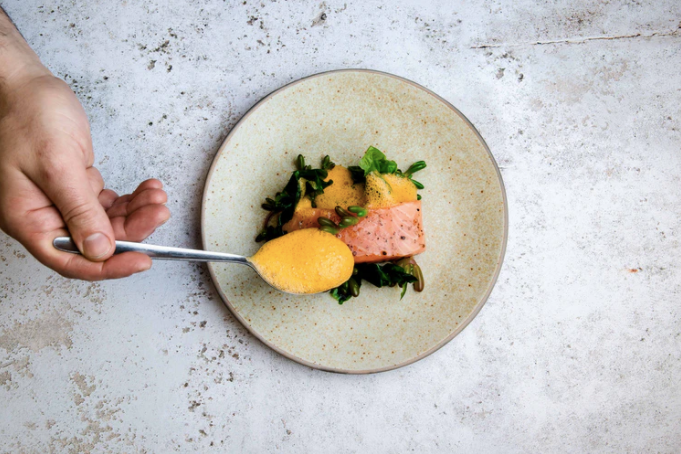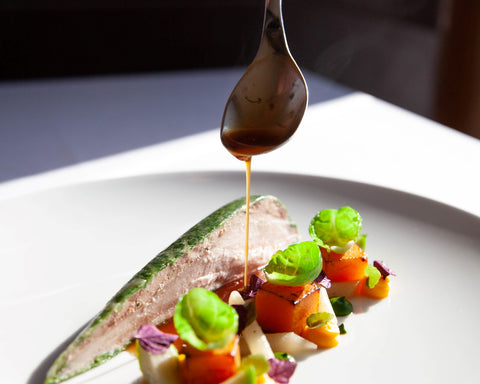
Our meals would be a lot dryer and duller without sauces, wouldn’t they? Can you imagine a carbonara without the creamy sauce? We certainly can’t. A beef bourguignon without the deep red wine sauce? It doesn’t bear thinking about.
Let’s face it - sauces make the meal. However, we understand that it’s not always easy to make a delicious sauce. In fact, making sauces from scratch can seem pretty overwhelming, even to an experienced cook.
But worry not - if you’ve got a dinner party coming up or simply want to improve your cooking, we’re here to help you shine in the sauce department. Whether you want to make your sauces thicker, tastier, or just a little more exciting, we’ve put together this guide full of tips on how to do it.
Simply read on to find out how to make delicious sauces and remember to check out our range of Sauce Pans because you can’t be an excellent chef without excellent tools.
Make your own stock if possible
Buying little stock pots from the supermarket may be simpler, but making your own stock is a guaranteed way to make your sauces taste fresher and more authentic. Luckily for all keen chefs, doing this isn’t as complicated as it sounds.
Whenever you cook, make sure you save all your meat and vegetable scraps because these will allow you to make a great stock. You simply have to cover the scraps in water, add a pinch of salt, boil it all at a simmer for around one to four hours, and voilà - you’ll have a homemade stock that will instantly improve your sauces.
However, this won’t just make your sauces taste better, it’ll also make them healthier because you can control the amount of salt that goes in them. This is especially beneficial if you find the flavour of shop-bought stock pots a little overpowering or are following a low-sodium diet.
Making your own stock is also a great way to cut down on waste because you’ll use up all your scraps. Delicious and eco-friendly, what more could you want?
Use good quality, fresh ingredients
This probably goes without saying, but using good quality, fresh ingredients is essential when you’re making delicious sauces. For example, when you’re making meatballs in tomato sauce, you’ll want to rustle up the sauce with the freshest, plumpest tomatoes you can find to maximise flavour. Similarly, if you’re making a cheese sauce, make sure you buy a good quality, strong cheddar to make sure the sauce is bright and vibrant.
Finding great quality ingredients in the supermarket can sometimes be a little tricky, so you may like to visit local farms, butchers, and cheesemongers instead. Buying such fresh ingredients will certainly cost more, but we believe a delicious sauce is worth the extra pennies.
Thickening sauce with starch

A common and easy way to thicken sauce is with a starch, such as cornstarch or wheat starch. As well as making it thicker, using starch will make your sauce clearer by preventing it from getting cloudy, which is a big benefit if you want your sauce to look as appealing as possible.
To thicken your sauce with starch, simply add it in whilst you cook - for every 200ml of liquid, you’ll usually need to add one tablespoon of starch. However, if you want your sauce thicker, you may like to add a little more and if you want it thinner, you’ll want to add less.
As an additional bonus, most starch is gluten free, so one big advantage of using it to thicken sauces is that it’ll be suitable for any friends or family members who are gluten intolerant. Just make sure you check the packet beforehand to be on the safe side.
Thickening sauce without starch
The most common way to thicken sauce without starch is with flour, which has the wonderful ability to make sauces creamy and velvety. It’s usually advised that you add two teaspoons of flour to every litre of liquid, but you can always add more flour if you want to make your sauce extra-creamy.
An easy way to make a sauce creamy with flour is to create a flour slurry. To do this, simply put an equal amount of flour and cold water in a cup and stir until smooth. Once you have a smooth flour slurry, you should add it to the sauce and then cook them together for a few minutes to make your sauce nice and thick.

You can also use flour to create a roux, a mixture which consists of equal quantities of flour and melted butter. This is then used to thicken rich sauces such as the ultra-creamy béchamel sauce - perfect for comfort foods like hearty lasagnes and warming pasta dishes.
Another way you can thicken sauces is with tomato paste, which will also give any sauce a great burst of colour and flavour. However, the aforementioned colour and flavour makes it rather unsuitable for dairy-based or white sauces, so this isn’t as versatile an option as flour.
Pan sauces
You know those pesky bits of food that hang around at the bottom of your frying pans after you’ve finished cooking? They can actually be put to good use by serving as the key ingredients in a pan sauce.
After sauteing or frying meat, fish, veggies, or anything else, leave the remains at the bottom of the pan. You can then add wine, cider, or broth to deglaze all the scraps before adding butter and flour to turn it into a rich, creamy pan sauce that will make your taste buds sing. This type of sauce goes best with meat, so if you’re a big meat fan, you’ll definitely want to master it.
When making this sauce, we recommend using a sturdy, high-quality frying pan that will be big enough to accommodate all the ingredients and easy to clean. We have a huge range of frying Pans that would be perfect, so you’ll easily find a great one here.
Taste as you cook

When cooking up a sauce, it’s easy to put all your focus on following the recipe word-for-word and measuring ingredients with military precision. However, there’s a much less scientific way to make sure your sauce will turn out delicious - simply by tasting it as you cook!
People often fall into the trap of tasting their sauce at the very end of cooking and then throwing in a little salt or spices to improve flavour, but by this point it’s usually too late for those flavours to kick in. It’s therefore a good idea to taste your sauce throughout the cooking process and add in salt, pepper, herbs, and spices as you see fit to ensure that the flavours have enough time to settle into the sauce.
After all, you’re cooking a sauce for yourself and loved ones, so veering off the cookbook tracks and following your gut (or taste buds) is the best way to give your sauce the personal touch. We think tasting as you go also makes cooking more fun and enjoyable.
Pair your sauce to your meal
Have you ever eaten a meal that should have been delicious but didn’t quite hit the spot? It was probably because the sauce didn’t complement the food. People often make the mistake of cooking up a delicious sauce and then pairing it with a meal that isn’t quite right, quashing all the sauce’s delicious potential. You could make a meal worthy of a Michelin star and a sauce that would make Nigella Lawson proud but still end up with a mediocre dish if the two didn’t complement each other.

You’re probably now wondering how to perfectly match a sauce and a meal. Luckily, it’s not too difficult. If you want to intensify the flavour of the food, make a sauce that tastes very similar. For example, if you’re making a beef dish and want it to be as intense and flavourful as possible, you should go with a rich sauce that uses beef scraps and stock.
However, you can also contrast two distinct flavours as long as they bring out the best in each other. For example, if you’re cooking a seafood dish, a lemon sauce is a great idea because the citrusy notes will brighten the salty flavour without overpowering it, creating the perfect balance. Tip: read here on how to use a lemon zester to get the most fragrant sauces!
Delicious sauces
From thickening sauces to tasting them, we hope this guide has given you some useful insight into the world of sauce-making and has made you feel ready to take on your next sauce with gusto.
Whether it’s for an important occasion or simply a nice family meal, we’re sure that everyone will be very impressed when they taste how delicious your sauces have become.
If you’d like more cooking tips, make sure you visit our blog and if you’d like some culinary inspiration, you may like to take a look at our recipes.
------
Liked this? Read more related articles from the experts at Zyliss:

